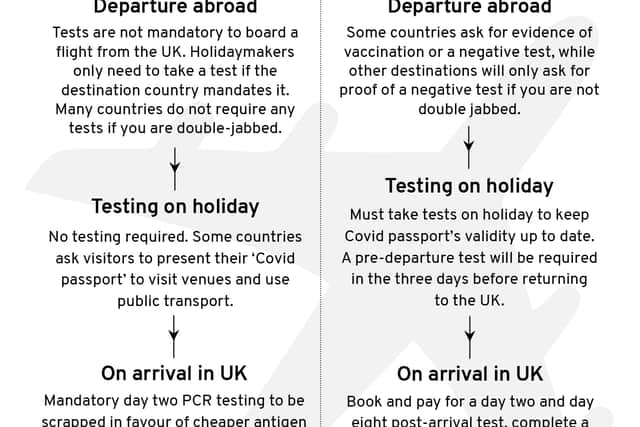Why is Dominican Republic on the red list? Covid cases, and rules on holidays in red list countries explained
This article contains affiliate links. We may earn a small commission on items purchased through this article, but that does not affect our editorial judgement.
and live on Freeview channel 276
Restrictions on international travel will be eased dramatically from next week, as the red list is slashed to just seven countries.
Transport Secretary Grant Shapps announced a major shake-up to the red list on Thursday (7 October) evening, confirming that 47 countries will be removed.
Advertisement
Hide AdAdvertisement
Hide AdWe want to hear from you: let us know what you think about this story and be part of the debate in our comments section below
The countries, which include South Africa, Mexico and Thailand, will be taken off England’s red list on Monday (11 October), leaving just seven destinations in the high-risk category.
The Dominican Republic is among the seven to remain, along with Colombia, Ecuador, Haiti, Panama, Peru and Venezuela.
The devolved administrations in Scotland, Wales and Northern Ireland set their own travel rules, but have recently mirrored the changes made in Westminster.
Advertisement
Hide AdAdvertisement
Hide AdBut why are these countries being kept on the red list and what does it mean for travellers? Here’s what you need to know.
Why is the Dominican Republic still on the red list?
The decision as to which countries are added or removed from the red list is based on a range of criteria, taking into account public health advice and the Joint Biosecurity Centre’s assessment of the latest Covid data.
The criteria for the lists includes:
- The percentage of a country’s population that have been vaccinated
- The rate of infection
- The prevalence of variants of concern
- The country’s access to reliable scientific data and genomic sequencing
The government’s decision to keep the Dominican Republic on the red list suggests that it is still considered to pose too high of a risk to public health for quarantine restrictions to be removed just yet.
The Dominican Republic recorded 4,867 new Covid-19 cases in the last seven day period, based on World Health Organization (WHO) data up to 8 October. This amounts to 44.87 cases per 100,000 population over the last seven days.
Advertisement
Hide AdAdvertisement
Hide AdThe UK Foreign Office states that a national State of Emergency has been declared in the country and a curfew is in place nationwide from 11pm to 5am.
There are some limited exceptions to the curfew, including those seeking assistance in a medical emergency, and international passengers and their drivers travelling to and from an airport. However, those who break the curfew may be arrested by the police.
La Altagracia (including Punta Cana) and Distrito Nacional are the only areas no longer under curfew due to their high vaccination rates. The Distrito Nacional is a subdivision of the capital city of Santo Domingo.
Mask-wearing and social distancing are also still mandatory in public spaces and private spaces for public use.


What are the rules for travelling to red list countries?
Advertisement
Hide AdAdvertisement
Hide AdThe rules for travelling to red list destinations apply whether you are fully vaccinated or not.
Those returning from a red list country or territory are required to spend 11 nights at a quarantine hotel, at a cost of £2,285 for solo travellers, and take a Covid-19 test on day two and day eight of self-isolation.
Travellers must also take a Covid-19 test in the three days before arrival in the UK and complete a passenger locator form.
These rules apply to both fully vaccinated and unvaccinated travellers.
Advertisement
Hide AdAdvertisement
Hide AdChildren aged 11 to 17 must also take a Covid-19 test in the three days before returning to the UK.
On arrival, children aged five to 17 must quarantine in a managed hotel for 10 full days and take two Covid-19 tests.
Those aged four or under do not have to take any travel tests but must enter managed quarantine.
If you make a transit stop in a red list country on your return to the UK, you may need to follow the red list rules when you arrive.
When will the red list be reviewed?
Advertisement
Hide AdAdvertisement
Hide AdThe government has conducted a review of the travel lists every three weeks based on assessments of the Covid-19 risk in each destination.
The changes of each review have tended to take effect from 4am four days afterwards, to allow people time to get home from a country where rules are changing if required.
Transport Secretary Grant Shapps told the Transport Select Committee on 22 September that the travel list reviews would continue to follow the same three-weekly timetable when the new simplified travel reviews were announced.
The latest review took place on Thursday 7 October, meaning the next review should come on Thursday 28 October.
Advertisement
Hide AdAdvertisement
Hide AdAs for a review of the international travel rules, the Department for Transport said: “We will look to set out a further review for the UK’s international travel policy early in the new year to provide further certainty for the spring and summer 2022 seasons.”
A message from the editor:
Thank you for reading. NationalWorld is a new national news brand, produced by a team of journalists, editors, video producers and designers who live and work across the UK. Find out more about who’s who in the team, and our editorial values. We want to start a community among our readers, so please follow us on Facebook, Twitter and Instagram, and keep the conversation going. You can also sign up to our newsletters and get a curated selection of our best reads to your inbox every day.
Comment Guidelines
National World encourages reader discussion on our stories. User feedback, insights and back-and-forth exchanges add a rich layer of context to reporting. Please review our Community Guidelines before commenting.
